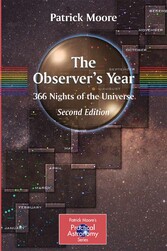
The Observer's Year - 366 Nights in the Universe

von: Patrick Moore
Springer-Verlag, 2006
ISBN: 9781846281556
Sprache: Englisch
376 Seiten, Download: 9082 KB
Format: PDF, auch als Online-Lesen
August (p. 214-215)
August 1
The August Sky
For the northern observer, the nights are lengthening. The Summer Triangle continues to dominate the scene, while the main autumn constellation, Pegasus, makes its entry in midevening. The Great Bear is rather low in the north-west, which means that the W of Cassiopeia is high in the northeast. Arcturus is setting, and Capella is so low over the northern horizon that any mist or light pollution will conceal it. We have lost the Scorpion, though Sagittarius remains on view very low in the south. In the early hours of the morning, the lovely star-cluster of the Pleiades appears in the east. By the end of August it rises well before midnight – a reminder that the hot days are over, and winter, with its frosts and fogs, lies ahead.
Remember that August is the ‘meteor month’. The Perseids, which peak on 12 August, may always be relied upon to give good displays, and even in the presence of the Moon quite a number of ‘shooting-stars’ can always be expected. The shower has already started at the beginning of the month, and goes on until near the end of the third week. From the southern hemisphere, the Vega-Deneb-Altair triangle is visible in the east, though only Altair is reasonably high from Australia or South Africa. Scorpius and Sagittarius remain prominent, though Scorpius is sinking in the west.
The Southern Cross is low, and so is Canopus, with the Southern Fish high up, and Pegasus appearing in the northeast. Of course the Perseids can be seen, but the radiant lies far in the north, so that for once Britons have the advantage over Australians. The Clouds of Magellan are gaining altitude, and this is a good time to pick out the admittedly rather confusing Southern Birds – Grus, Pavo, Phœnix and Tucana.
August 2
Neptune: the Outermost Giant
Throughout the period we are covering here, Neptune reaches opposition in the late northern summer – from 8 August in 2005 to 19 August in 2010; the synodic period is only 367.5 days. Throughout the period Neptune remains in Capricornus, around declination –19°; at the 2002 opposition it remains near the star Rho Capricorni, magnitude 4.8. Neptune’s mean opposition magnitude is 7.7.
This means that it is well below naked-eye visibility, but binoculars will show it in the guise of a starlike point. Telescopically it appears as a small, bluish disk, with an apparent diameter of around 2 seconds of arc. Ordinary telescopes will show no surface features, though markings have been recorded very distinctly from the Hubble Space Telescope – and of course from the one space-craft to have passed by it, Voyager 2 in 1989. There are 11 known satellites, of which 6 were found during and after the Voyager 2 encounter. Of the two attendants previously known, Triton is an easy telescopic object with adequate equipment, but Nereid is very faint indeed, and the recently-found satellites are beyond the range of Earth-based instruments.







